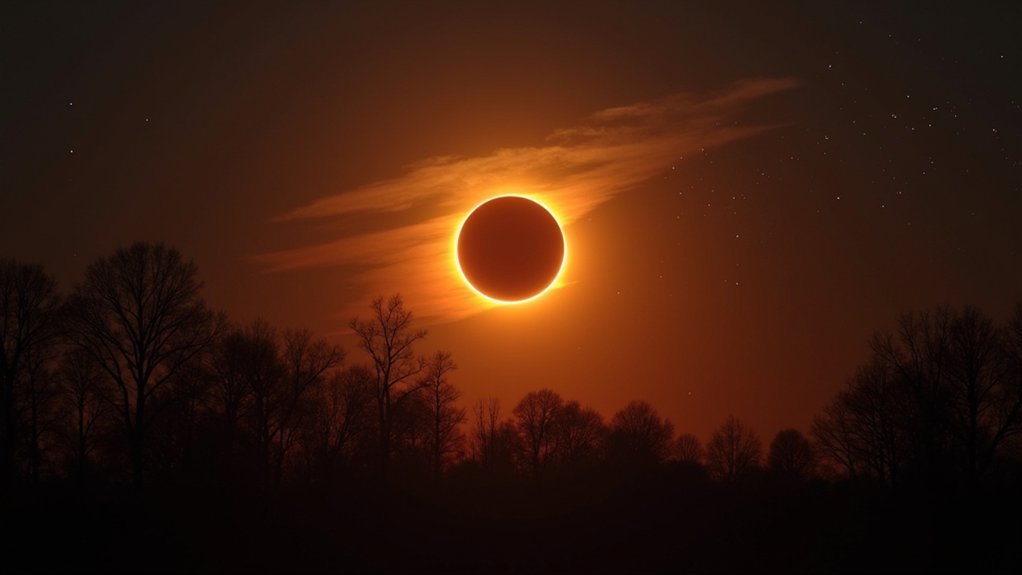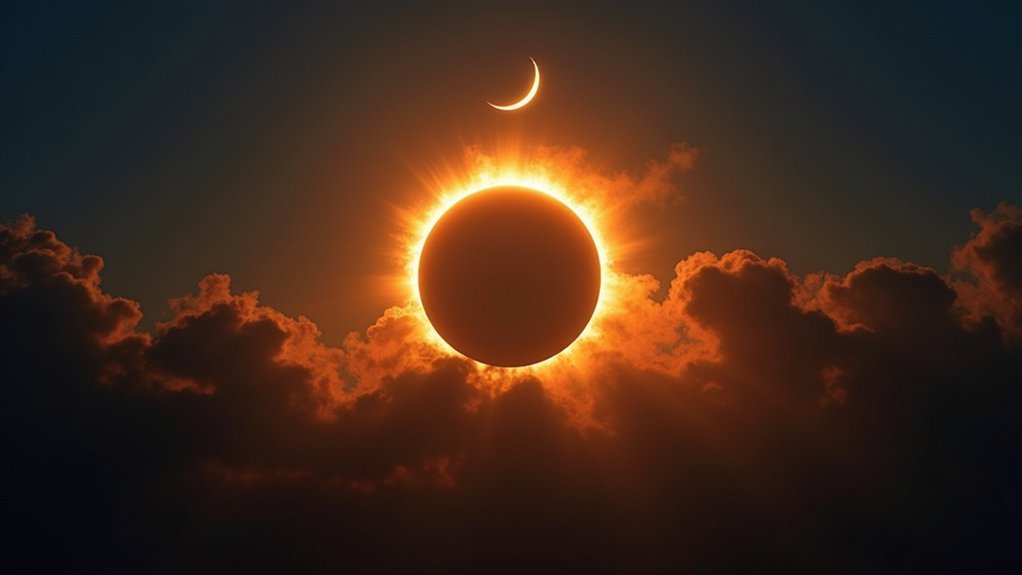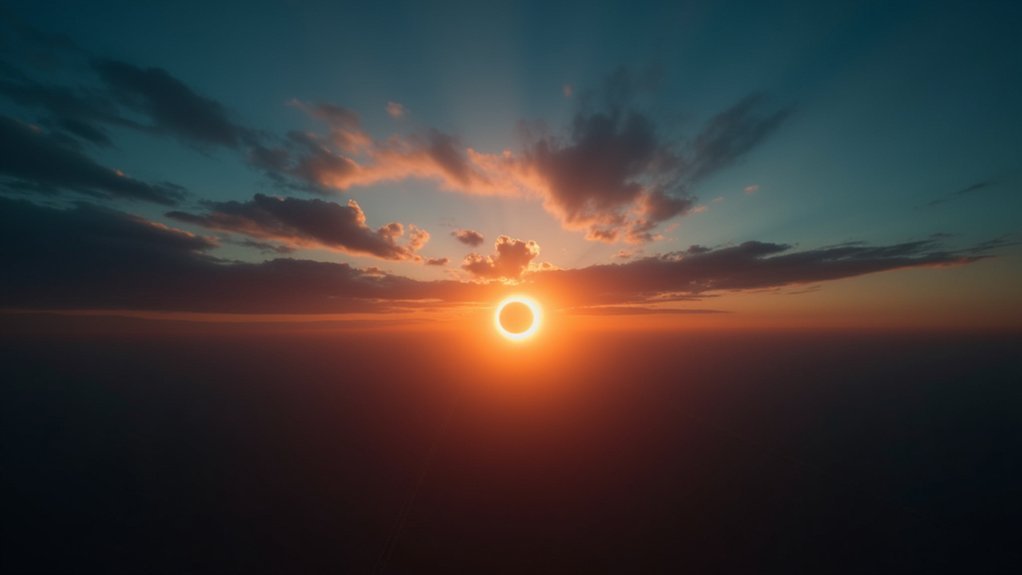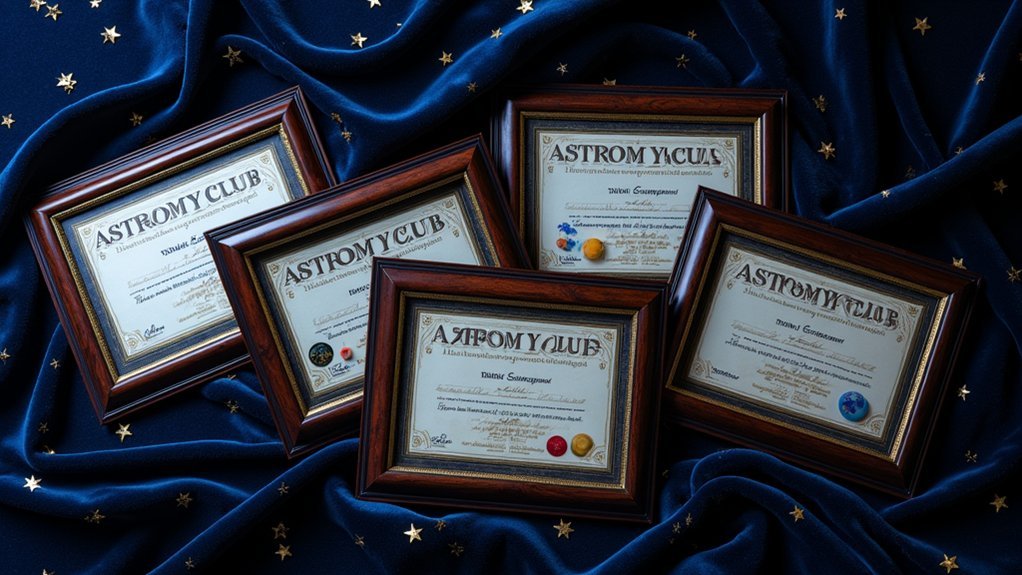Different types of eclipses occur due to variations in celestial alignments and distances. You’ll see total solar eclipses when the Moon perfectly blocks the Sun, annular eclipses when the Moon appears smaller and creates a “ring of fire,” and partial eclipses when alignment is imperfect. Lunar eclipses happen when Earth stands between the Sun and Moon, casting shadows that create “blood moon” effects. Understanding these cosmic positions reveals the fascinating mechanics behind each spectacular display.
The Celestial Dance: How Eclipse Alignments Work

When three celestial bodies align perfectly in space, they create one of nature’s most spectacular phenomena: an eclipse. This precise alignment, called syzygy, occurs when the Sun, Earth, and Moon form a straight line.
You’ll witness different types of eclipses depending on their specific arrangement. During a solar eclipse, the Moon positions itself between the Sun and Earth, casting its shadow on our planet.
In contrast, a lunar eclipse happens when Earth comes between the Sun and Moon, blocking sunlight from reaching the lunar surface.
The alignment isn’t always perfect. The Moon’s varying distance from Earth affects its apparent size relative to the Sun, creating total, partial, or annular solar eclipses.
The cosmic dance of distance determines how the Moon masks our star—completely, partially, or leaving a fiery ring.
Meanwhile, Earth’s larger shadow makes lunar eclipses visible to more people across the globe.
Total Solar Eclipses: When the Moon Perfectly Covers the Sun
The most dramatic celestial spectacle occurs during a total solar eclipse, when the Moon aligns precisely between Earth and the Sun, completely blocking the Sun’s brilliant disk.
If you’re lucky enough to stand within the narrow path of totality—typically just 160 kilometers wide—you’ll witness the Sun being completely obscured, plunging your surroundings into twilight.
During these rare events, the Sun’s corona becomes visible as a shimmering halo around the blackened disk.
Total eclipses occur only 2-5 times annually worldwide, and you’ll need to be in specific geographic locations to experience one.
Observers outside the path of totality will see only a partial solar eclipse, where the Moon covers just a portion of the Sun.
This alignment creates a moving shadow that travels across Earth’s surface.
Annular and Partial Solar Eclipses: Rings of Fire and Cosmic Bites

Unlike total solar eclipses where the Moon fully obscures the Sun, annular and partial solar eclipses create distinctly different visual phenomena.
When you witness an annular solar eclipse, you’ll see the “ring of fire” effect that occurs when the Moon is at its farthest point from Earth. Though aligned with the Sun, the Moon appears smaller, unable to completely cover the Sun, leaving a bright ring visible around its edges.
In contrast, during a partial eclipse, the Moon takes a “bite” out of the solar disk due to imperfect alignment between celestial bodies. These types of solar eclipses are more common than total eclipses, with partial eclipses occurring up to five times yearly.
The primary visual differences between these eclipse types stem from our solar system’s geometry—specifically the Moon’s distance from Earth and its apparent size relative to the Sun.
Lunar Eclipse Varieties: Earth’s Shadow on the Moon
While solar eclipses captivate viewers with their daytime darkness, lunar eclipses offer equally mesmerizing celestial displays when our planet becomes the star of the show.
When Earth positions itself directly between the Sun and Moon, its shadow creates a stunning cosmic event you can view from anywhere on the night side of our planet.
You’ll encounter three distinct varieties of lunar eclipses:
- Total lunar eclipse – The Moon passes completely into Earth’s umbra, creating the famous “blood moon” with its reddish hue.
- Partial eclipse – Only a portion of the Moon enters Earth’s umbra.
- Penumbral eclipse – The Moon travels through Earth’s faint outer shadow.
- Hybrid eclipse – Changes between eclipse types during the event.
Scientists can calculate future lunar eclipses with precision by tracking the relative positions of these celestial bodies.
Viewing Different Eclipses Safely: Protection and Observation Tips

Every eclipse viewing experience demands specific safety considerations, as your eyes deserve protection from potentially harmful solar radiation.
When a solar eclipse occurs, you must use ISO 12312-2 certified eclipse glasses—regular sunglasses won’t protect you when the Sun is partially obscured by the Moon.
You can also safely view the eclipse using the pinhole projection method, creating a simple viewing device that projects the Sun’s image onto a flat surface.
Consider attending public viewing events hosted by astronomical societies, where you’ll find properly equipped telescopes.
When a lunar eclipse occurs, you’re in luck—no special eye protection is needed.
You can observe the Moon entering Earth’s shadow directly, even enhancing your view with binoculars or telescopes for a more detailed experience.
Frequently Asked Questions
Why Are There Different Types of Eclipses?
Different types of eclipses occur because you’re seeing varying alignments between the Sun, Earth, and Moon. The Moon’s changing distance from Earth and their orbital paths create total, annular, partial, or lunar eclipse varieties.
Why Does Everyone Not See the Same Type of Eclipse?
Your location on Earth determines what eclipse you’ll see. If you’re in the Moon’s umbra, you’ll witness a total eclipse, while those in the penumbra see partial ones. Geography dictates your eclipse experience.
Why Do We See Eclipses and When Do We See Them?
You’ll see eclipses when the Sun, Earth, and Moon align perfectly. Solar eclipses occur at new moons when the Moon blocks the Sun, while lunar eclipses happen at full moons when Earth’s shadow darkens the Moon.
Why Do We See More Lunar Eclipses Than Solar Eclipses?
You’ll see more lunar eclipses because they’re visible from anywhere on Earth’s night side, while solar eclipses require you to be in a specific location. Lunar eclipses also have less strict alignment requirements.
In Summary
You’ve learned why we see different eclipse types—it’s all about positioning! When the Sun, Moon, and Earth align at different angles and distances, you’ll witness everything from total solar eclipses to lunar eclipses. Remember, these cosmic events aren’t just spectacular; they’re the result of precise astronomical movements. Next time you’re watching an eclipse, you’ll understand the celestial mechanics behind this awe-inspiring phenomenon.





Leave a Reply